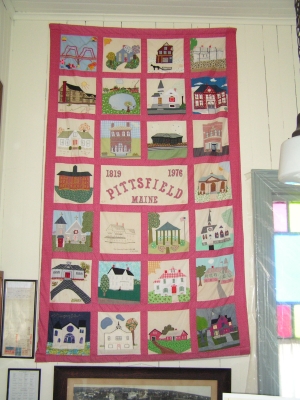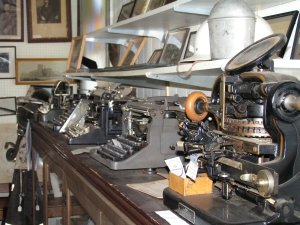 Display of old bottles, including “Ess. of Peppermint” from Humphrey’s Pharmacy, and Glycerin from Henry Libby, Pharmacist. Display of old bottles, including “Ess. of Peppermint” from Humphrey’s Pharmacy, and Glycerin from Henry Libby, Pharmacist.
|
 Ceramics painted with various Pittsfield buildings. Ceramics painted with various Pittsfield buildings.
|
 Historical Registry certificate for the Depot House. Historical Registry certificate for the Depot House.
|
 Mantle clock. Mantle clock.
|
 Plates decorated with various Pittsfield Churches. Plates decorated with various Pittsfield Churches.
|
 Girl Scout uniforms from the 1950s (left) and 1980s. Girl Scout uniforms from the 1950s (left) and 1980s.
|
 Old telephones in use in Pittsfield from the early to mid 1900’s. Both wall mounted and the more “modern” tabletop types are shown. Old telephones in use in Pittsfield from the early to mid 1900’s. Both wall mounted and the more “modern” tabletop types are shown.
|

Old tools hand on one wall and suspended from ceiling. Clockwise from upper left:
- Grain flail for beating grain sheaves to remove grain from the stalks. The long five foot handle was connected via a leather strap to a shorter two foot beater. Flailing was usually done on the barn floor on a tarp; the resulting grain and chaff mix was then fed through a winnower to separate the grain from the chaff.
- Two-man crosscut saw for sawing logs. Two men holding identical handles at either end of the saw would each take turns pulling the saw toward them. This design not only made for quicker and less tiresome sawing, but the size of the log that could be cut was limited only by the length of the saw blade.
- One-man crosscut saw for sawing logs. Note blade tightening mechanism at top. One man would hold the saw with one hand between blade and crossbar, the other hand on the descending handle. It was operated with an alternating push-pull motion, the weight of the saw providing most of the downward pressure.
- Ice saw for cutting ice from frozen lakes and rivers, and from ice houses. Because these saws were made for sawing downward, the handles are perpendicular to the blade. In the times before mechanical refrigeration became widespread (prior to 1930-1950), winter ice was stored for use during the summer. In the winter ice would be cut and hauled ashore to be stored in ice houses, simple barn-like structures with double walls and roof, which were often filled with sawdust for insulation. On tidal rivers this enabled the export of ice on sailing ships to the southern climes, where summertime ice brought a good price. In most parts of the country stored winter ice was the only means of summertime refrigeration, and a whole trade arose of the ice supply companies, and the ice man who would make regular bi-weekly deliveries of blocks of ice to homes and businesses, to restock the ice-boxes.
- Scythe for hand mowing grains and hay. The bent shaft (“snath”) and upper and lower offset handles made it easier to swing the blade parallel to the ground for a more even cut.
- Lopper pruners for trimming branches on trees. Annual pruning of trees such as apple guarantees annual production on trees that would otherwise tend to bear biennially.
- A modern one-man bow saw, replacement for the crosscut saw above. Lighter and with a thinner blade, it cut faster and was easier to carry. The blade was usually discarded when dull and replaced with a new one, although special tools did exist for sharpening these thinner blades, too. Note attached knob handle for upper hand.
|
 Display shelf with old railroad insulators, photos and anniversary plates. Display shelf with old railroad insulators, photos and anniversary plates.
|
 Schoolhouse clock with a wind-up mainspring, and pendulum to keep accurate time. On the outside of the dial are the days of the month; on months shorter than 31 days, the clock month hand had to be gently moved forward to the next month after the 28th, 29th or 30th day. The monogram is likely for either the owner or a small scale clock mechandiser, not the manufacturer. Schoolhouse clock with a wind-up mainspring, and pendulum to keep accurate time. On the outside of the dial are the days of the month; on months shorter than 31 days, the clock month hand had to be gently moved forward to the next month after the 28th, 29th or 30th day. The monogram is likely for either the owner or a small scale clock mechandiser, not the manufacturer.
|
 . .
|
  Old typewriters from the early 1900’s. Old typewriters from the early 1900’s.
|
 Wedding dress. In background is Anna Parker Martin’s spinning wheel. Wedding dress. In background is Anna Parker Martin’s spinning wheel.
|
 In 2005 we finally got display cases built for our old gun collection. Volunteers Clum Spencer and Dale Small (pictured) assembled the display cases. In 2005 we finally got display cases built for our old gun collection. Volunteers Clum Spencer and Dale Small (pictured) assembled the display cases.
|
 Project completed! The gun display. Project completed! The gun display.
|



















